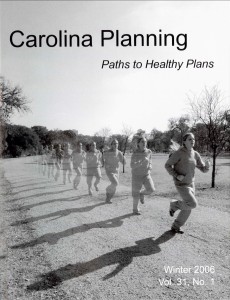 Volume 31.1 Paths to Healthy Plans (2006)
Volume 31.1 Paths to Healthy Plans (2006)
Public health and planning are overlapping disciplines, and schools such as UNC-Chapel Hill are beginning to acknowledge this overlap through dual degree programs and interdisciplinary curricula. Despite the fields’ large and growing connection in academia, their interrelation has yet to become commonplace in professional planning circles. We hope this issue of Carolina Planning helps introduce readers to some of the language, research, and practices of public health as applied in planning.
Editors: Laura Sandt, Rawley Vaughan, Allan Freyer, and Michael Schwartz
A digital version of this issue is available here.
| CONNECTING PUBLIC HEALTH AND PLANNING: BUILDING HEALTHY COMMUNITIES
Solomon, Jessica Research increasingly points to the impact that planning and design can have on the health of communities. This article provides an introduction to the connection between planning and public health, examples of tools that local practitioners can use to build cross-disciplinary partnerships, and examples of how agencies across the country have worked together to improve health outcomes and quality of life in their communities. |
| POSTCARD FROM THE PIEDMONT
Wear, John E., Jr. |
| THE NORTH CAROLINA PHYSICAL ACTIVITY POLICY RESEARCH CENTER: MAKING CONNECTIONS WITH NORTH CAROLINA PLANNERS
Evenson, Kelly R.; Fesperma, Carrie; Aytur, Semra A.; Brown, Austin, Rodríguez, Daniel A.; Salvesen, David Physical activity participation for youth and adults is suboptimal in North Carolina. There is growing interest among policy makers to promote physical activity, yet research in this area is limited. The North Carolina Physical Activity Policy Research Center was established in 2004 to conduct research on physical activity and policy. This cross-disciplinary center brings together faculty and researchers from the University of North Carolina School of Public Health and the College of Arts and Sciences. Current projects include understanding and documenting polices that affect walking and bicycling to school, trail development, and community planning decisions related to physical activity. |
| LAND USE AND TRANSPORTATION PLANNING TO PROMOTE PHYSICAL ACTIVITY IN NORTH CAROLINA
Aytur, Semra A. With national and state agencies as well as leading public health foundations providing impetus, efforts to improve the understanding of policy and environmental attributes that may support active lifestyles have become a promising area for collaboration between planning and public health professionals. This article highlights the results of work performed at the University of North Carolina at Chapel Hill examining the relationship between planning policies and physical activity and the prevalence of land use policies and implementation tools that might support the viability of non-motorized modes. With the hope of bridging research and practice, it discusses findings most relevant to planners interested in the broader health-related applications of their work. |
| IMPROVING THE SCHOOL DEVELOPMENT PROCESS IN CABARRUS COUNTY, NC: A COOPERATIVE EFFORT
Lentz, Rodger H. School facilities are the most expensive public facilities provided by state and local government in North Carolina. School facilities are also one of our greatest physical assets in that they can become centers of activity for the communities surrounding them. Unfortunately, bottom line costs for land tend to be the driving force in school development rather than the positive and negative implications that the location of school facilities can have on an area. This article provides some background to the school location and development issue and describes action taken in Cabarrus County to improve the process. |
| NORTH CAROLINA’S DISASTER RESPONSE TO HURRICANE KATRINA: THE STATE MEDICAL ASSISTANCE TEAMS
Rudisill, Michele L. In the wake of Hurricane Katrina, the State of North Carolina responded to the disaster by deploying the State Medical Assistance Team (SMAT) to Waveland, MS, a Gulf town ravaged by the hurricane. The author of this article, Michele Rudisill, RN, BSN, helped lead the first deployment of the SMAT Field Hospital in Waveland. Her story describes the successful pre-disaster coordination between North Carolina’s various medical response organizations that allowed the team to quickly deploy to the region and almost immediately begin providing critical medical services to the surrounding population. This response was so effective that the SMAT effort is now recognized nationally as a model system for disaster response. |
| FLOYD IN RETROSPECT
Tibbetts, John H. The text below is comprised of sections from the article “Floyd Follies: What We’ve Learned” published in Coastal Heritage Magazine, Volume 17, number 1, in 2002. It highlights improvements made to South Carolina’s emergency preparedness after Hurricane Floyd exposed serious flaws in the former evacuation plan. Given the similar revelation of recent failures in the evacuation plans of New Orleans and Houston, the editors felt this piece warranted a second look. New research is being done on best practices in emergency evacuation management (see Lessons from Katrina and Rita—http://www.vtpi.org/katrina.pdf), and planners may want to fit some of the recommendations described in this article into the context of 2005. In addition, the article highlights the behavior tendencies of key targets for emergency response planners. This information can help shape the way in which evacuation plans address the issues and concerns of these varied stakeholders. Words in brackets have been added by the author for clarification purposes. |
| INTERVIEW WITH RANDY MUNDT, NORTH CAROLINA STATE HAZARD MITIGATION OFFICER
Carolina Planning Editors Randy Mundt works for the State of North Carolina, mapping floodplains for the Division of Emergency Management (NCEM). He is well-versed in the world of hazard mitigation—stopping disasters before they start. Find out more about his office’s work online at www.ncem.org or www.ncfloodmaps.com. Carolina Planning (CP) conducted the phone interview transcribed below on September 30, 2005. |